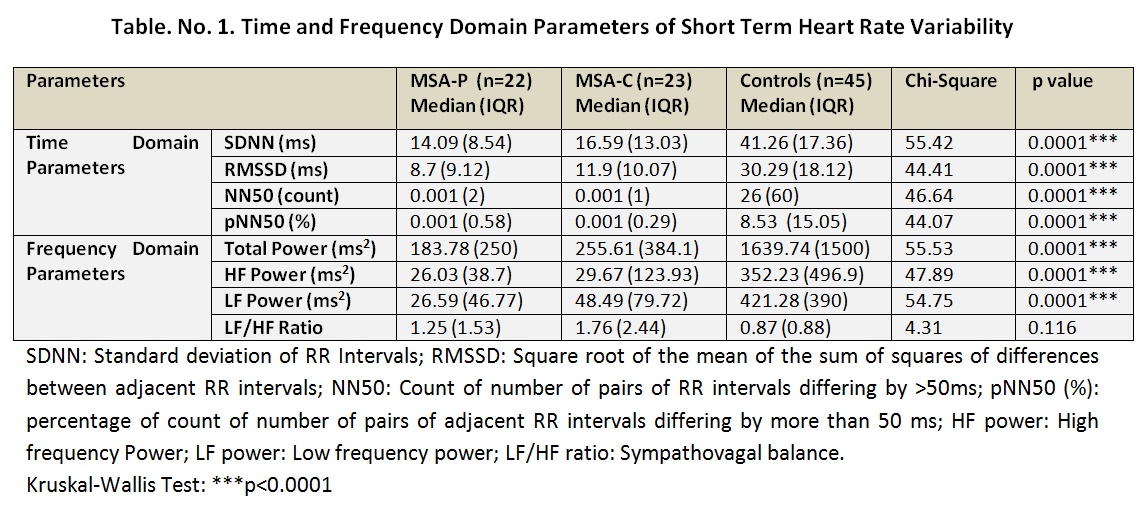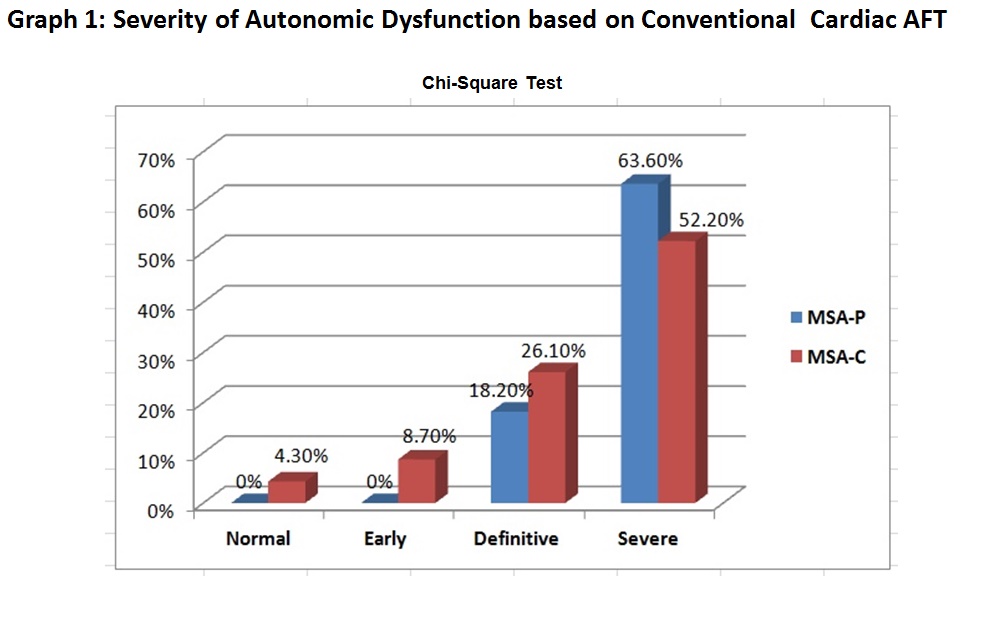Session Information
Date: Monday, June 5, 2017
Session Title: Parkinsonism, MSA, PSP (Secondary and Parkinsonism-Plus)
Session Time: 1:45pm-3:15pm
Location: Exhibit Hall C
Objective: The objective was to retrospectively study the nature of cardiac autonomic dysfunction and the effect of phenotype on it in probable Multiple System Atrophy (MSA) patients.
Background: MSA is an adult onset, sporadic, neurodegenerative disorder. It has parkinsonian (MSA-P) and cerebellar (MSA-C) motor subtypes. Limited data exists on the nature of cardiac autonomic dysfunction in Indians affected with MSA. Assessing the differences in the severity of autonomic dysfunction between the subtypes facilitates better understanding as to which has better prognosis
Methods: It is a retrospective descriptive study. Probable MSA patients who attended our hospital between May 2011 and May 2016, fulfilled diagnostic criteria given by Second Consensus statement and did not have any other co-morbid neurological, psychiatric or systemic illness constituted the study population. There were 45 Probable MSA patients (MSA-P=22; MSA-C=23) and 45 age and gender matched healthy controls. Conventional cardiac autonomic function testing (AFT) and short term heart rate variability (HRV) were the study tools. Differences between MSA-P, MSA-C and control groups were analyzed by parametric and non-parametric tests as appropriate.
Results: There were 31 males and 14 females in both MSA and control groups. Mean age of MSA patients was 55.68±8.09yrs and controls was 55.64±8.86yrs. Mean age of onset of MSA was 53±8yrs. Median disease duration was 3yrs. Among MSA patients, 55.6% reported postural symptoms and 73.3% reported bladder disturbances. Conventional cardiac AFT showed that in MSA-P group, 18.2% had definitive and 63.6% had severe cardiac autonomic dysfunction while in MSA-C group, 8.7% had early, 26.1% had definitive and 52.2% had severe cardiac autonomic dysfunction. However, there was no significant difference between subtypes [Graph 1]. HRV analysis showed that overall HRV, sympathetic activity and parasympathetic activity was significantly reduced in both MSA-P and MSA-C patients as compared to controls (p<0.0001). However, there was no significant difference in HRV parameters between subtypes [Table 1].
Conclusions: There is autonomic dysfunction in MSA patients as evidenced by symptomatology, conventional cardiac AFT and HRV. Sympathetic as well as parasympathetic nervous system is affected in MSA. There is similarity in the nature of cardiac autonomic dysfunction between the MSA-P and MSA-C phenotypes.
References:
- Schmidt C, Herting B, Prieur S, Junghanns S, Schweitzer K, Globas C et al. Autonomic dysfunction in different subtypes of multiple system atrophy. Mov Disord. 2008 Sep 15;23(12):1766-72. doi: 10.1002/mds.22187.
- Malik M. Clinical guide to cardiac autonomic tests. Dordrecht: Kluwer Academic Publishers; 1998.
To cite this abstract in AMA style:
M. Rukmani, R. Yadav, P. Pal, B. Bhaskarapillai, T. Sathyaprabha. Cardiac Autonomic Dysregulation in Probable Multiple System Atrophy [abstract]. Mov Disord. 2017; 32 (suppl 2). https://www.mdsabstracts.org/abstract/cardiac-autonomic-dysregulation-in-probable-multiple-system-atrophy/. Accessed April 2, 2025.« Back to 2017 International Congress
MDS Abstracts - https://www.mdsabstracts.org/abstract/cardiac-autonomic-dysregulation-in-probable-multiple-system-atrophy/


